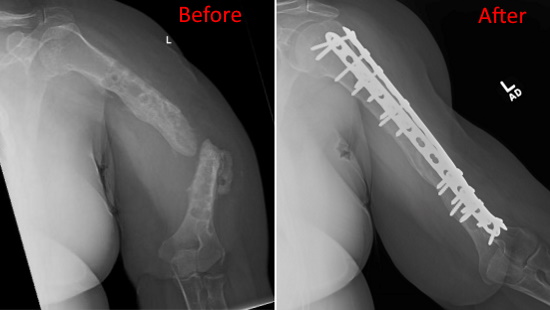Signs a Broken Bone is Not Healing
The signs that a broken bone is healing are often typically an improvement in mobility and a decrease in pain. While the progress may not be consistent, each week should be an improvement from the previous.
But the signs that your broken bone is not healing properly may be less clear cut.
What do you do if you suspect there is a problem with your fracture? Or if a previously healed fracture begins to give you new troubles, such as arthritis?
Don’t automatically assume that you have to live with pain or mobility limitations after a fracture. Find an orthopedic trauma specialist with the expertise to diagnose and treat many types of fracture healing problems.
Shock Trauma Problem Fracture Program
Renowned for treating the most complex fractures at the time of injury, the UMMC Shock Trauma team of orthopedic specialists also brings their expertise to previous fractures that continue to have problems.
Our orthopedic trauma surgeons are global leaders in the research and development of cutting-edge treatment strategies to restore function and mobility after a traumatic injury.
For patients, who need specialized care for a problem fracture, they offer:
- Outpatient evaluation and care
- Second opinions
- Corrective surgery
Make an Appointment
Appointments are available within one week, and sooner for urgent cases. Call 410-448-6400 to schedule. No referral is needed. You may also request an appointment online
Referrals and Physician Services
In addition to providing direct patient care, our orthopedic trauma surgeons offer second opinions and senior-level consultation to external physicians for complex cases. Referring to the Problem Fracture Program
Locations
Shock Trauma Outpatient Pavilion at UMMC
23 Penn Street, Room TGR 100
Baltimore, MD 21201
University of Maryland Orthopaedics at Camden Yards
351 West Camden Street, Suite 501
Baltimore, MD 21201

Types of Fracture Healing Problems
Many factors can affect how a bone fracture heals. Too much movement, poor alignment of the fractured bone and/or substantial damage to the muscle and skin around a fracture can lead to longer healing times or a fracture not healing at all.
Nonunion and Malunion Fractures
Nonunions and malunions happen when fractures heal poorly or not at all. Nonunion means that a fracture has not healed in the time expected. A fracture malunion is a fracture that has healed with the bone in an incorrect position, such as with limb shortening or rotation or incorrect rotation.
Post-Traumatic Arthritis
Post-traumatic arthritis is a condition that leads to joint pain, following an injury. This can be treated in a variety of ways, including focused physical therapy, pain relieving injections, and in more severe cases, surgical treatment.
Bone Infection or Infection After Surgery
Bone infections (osteomyelitis) can be the result of severe fractures that come through the skin at the time of injury, or may develop after fracture surgery. This is typically due to the contact with germs that can occur during severe injuries or in the process of surgically repairing broken bones or performing joint replacements.
Leg Length Discrepancy After a Fracture
One of the ways that a bone may heal improperly is with the bone ends in a shortened position. This can lead to a sense that one limb is shorter than the other. Minor limb length discrepancies may be fixed with a shoe lift for the shorter limb. However, in some cases. a surgical correction to restore proper length of the limb may be the best treatment.
